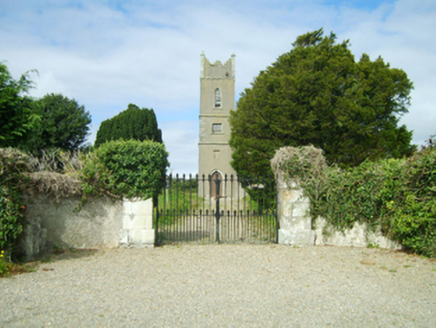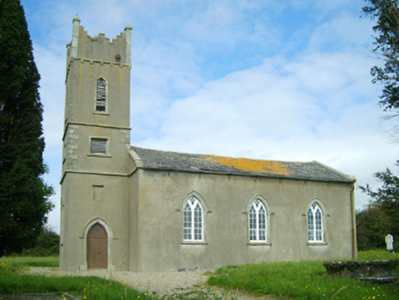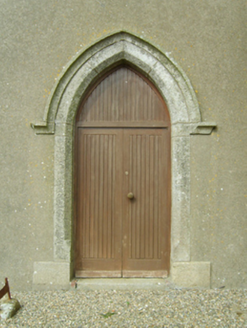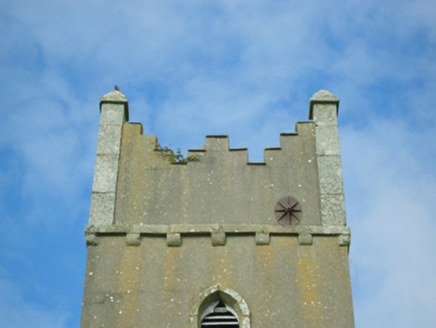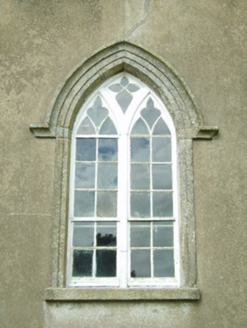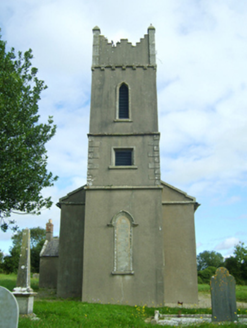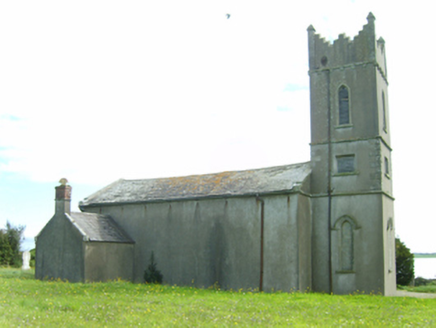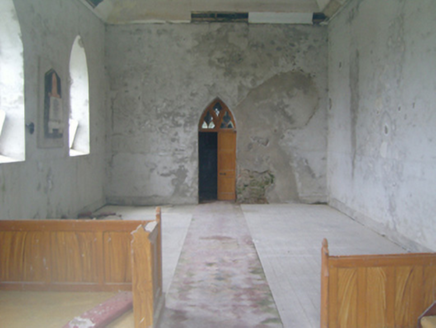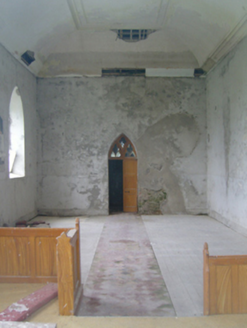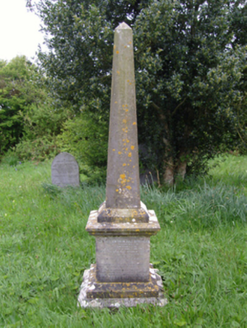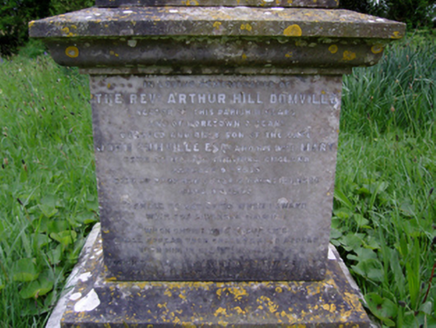Survey Data
Reg No
15704520
Rating
Regional
Categories of Special Interest
Architectural, Artistic, Historical, Social
Original Use
Church/chapel
Date
1815 - 1820
Coordinates
280168, 109183
Date Recorded
05/09/2007
Date Updated
--/--/--
Description
Detached three-bay double-height single-cell Board of First Fruits Church of Ireland church, built 1818, on a rectangular plan with single-bay three-stage tower to entrance (west) front on a square plan. Closed, 1992. Now disused. Pitched slate roof with lichen-covered clay ridge tiles, cut-granite coping to gables, and cast-iron rainwater goods on cut-granite eaves retaining cast-iron octagonal or ogee hoppers downpipes. Rendered battered walls; rendered surface finish to tower with cut-granite stringcourses including cut-granite stringcourse (bell stage) on cut-granite beaded consoles supporting pyramid-topped cut-granite piers centred on rendered crow stepped battlemented parapets having lichen-covered rendered coping. Pointed-arch window openings with cut-granite sills, timber Y-mullions, and cut-granite surrounds having rebated reveals with "Cavetto" hood mouldings over framing six-over-four timber sash windows without horns. Pointed-arch window opening to chancel (east) with cut-granite sill, interlocking timber Y-mullions, and cut-granite surround having rebated reveals with "Cavetto" hood moulding over framing fixed-pane timber fittings. Lancet window opening to tower (first stage) with cut-granite sill, and cut-granite surround having rebated reveals with "Cavetto" hood moulding over framing concrete block infill. Square-headed openings (second stage) with cut-granite sills, and cut-granite surrounds having chamfered reveals framing louvered timber fittings. Lancet openings (bell stage) with cut-granite sills, and cut-granite surrounds having chamfered reveals framing louvered timber fittings. Interior including vestibule (west); pointed-arch door opening into nave with timber panelled door having overlight; full-height interior with tessellated terracotta tiled central aisle, cut-white marble Classical-style wall monuments (ob. 1842; 1892) with pair of polished brass plates (ob. 1875; 1941), trefoil-perforated timber panelled pulpit on an octagonal plan with trefoil-perforated timber clerk's desk, timber boarded stepped dais to chancel (east) with wrought iron-detailed barley twist balusters supporting timber communion railing centred on altar below "East Window", and moulded plasterwork cornice to vaulted ceiling centred on moulded plasterwork ceiling rose. Set in unkempt grounds on a slightly elevated site with granite ashlar piers to perimeter having overgrown capping supporting wrought iron double gates.
Appraisal
A church erected with financial support from the Board of First Fruits (fl. 1711-1833) representing an important component of the early nineteenth-century ecclesiastical heritage of south County Wexford with the architectural value of the composition, 'a neat edifice in the later English style with a square tower crowned with pinnacles' (Lewis 1837 II, 627), confirmed by such attributes as the standardised nave-with-entrance tower plan form, aligned along a skewed liturgically-correct axis; the "pointed" profile of the openings underpinning a contemporary Georgian Gothic theme with the chancel defined by an elegant "East Window"; and the crow stepped battlements embellishing the tower as a picturesque eye-catcher in the landscape. A prolonged period of neglect notwithstanding, the elementary form and massing survive intact together with substantial quantities of the original fabric, both to the exterior and to the vaulted interior where contemporary joinery; wall monuments commemorating the Boyds of Kiltra House (see 15704540) and the Cocloughs of Tintern Abbey; and sleek plasterwork refinements, all highlight the artistic potential of a church making a pleasing visual statement overlooking Bannow Bay.
